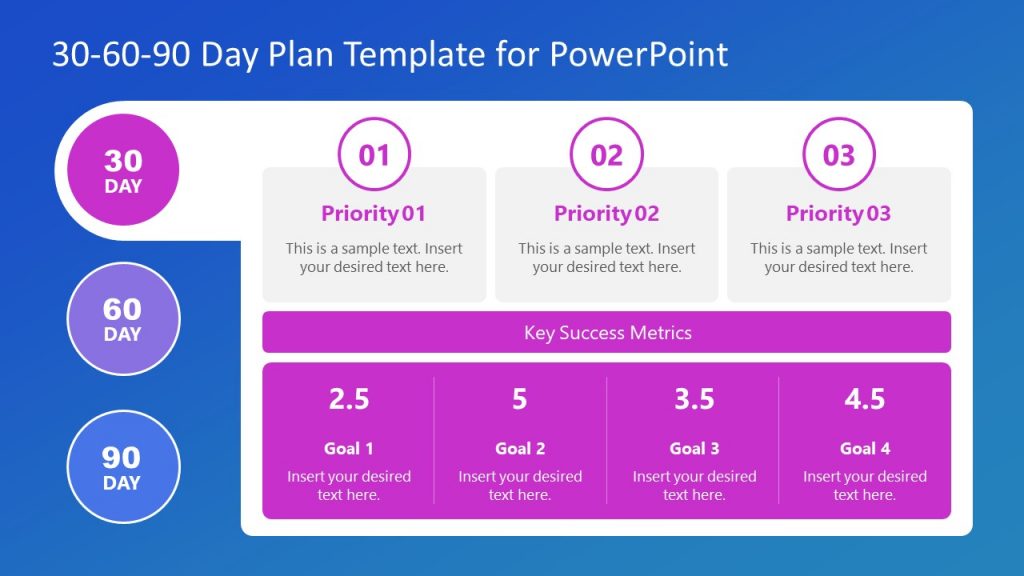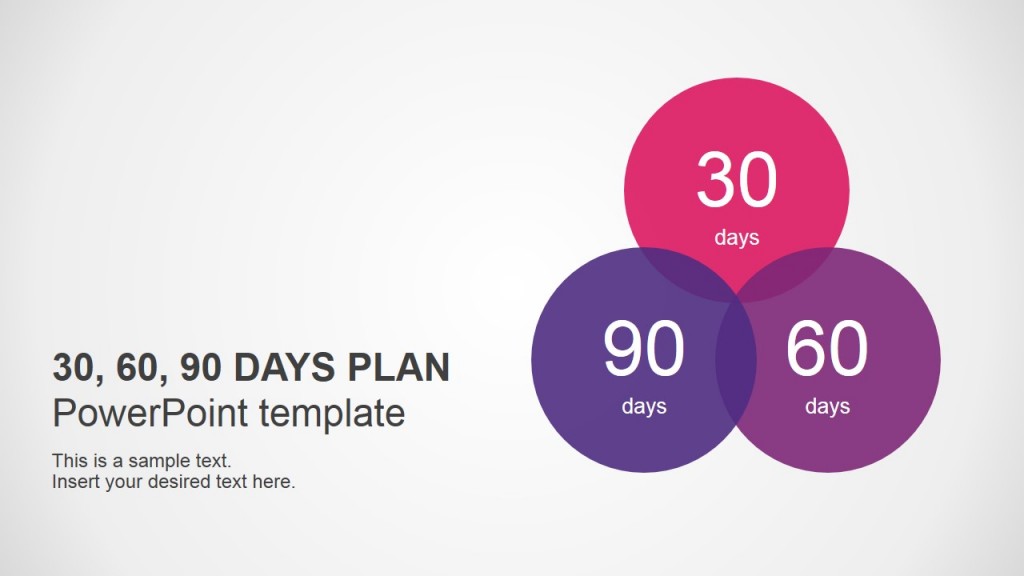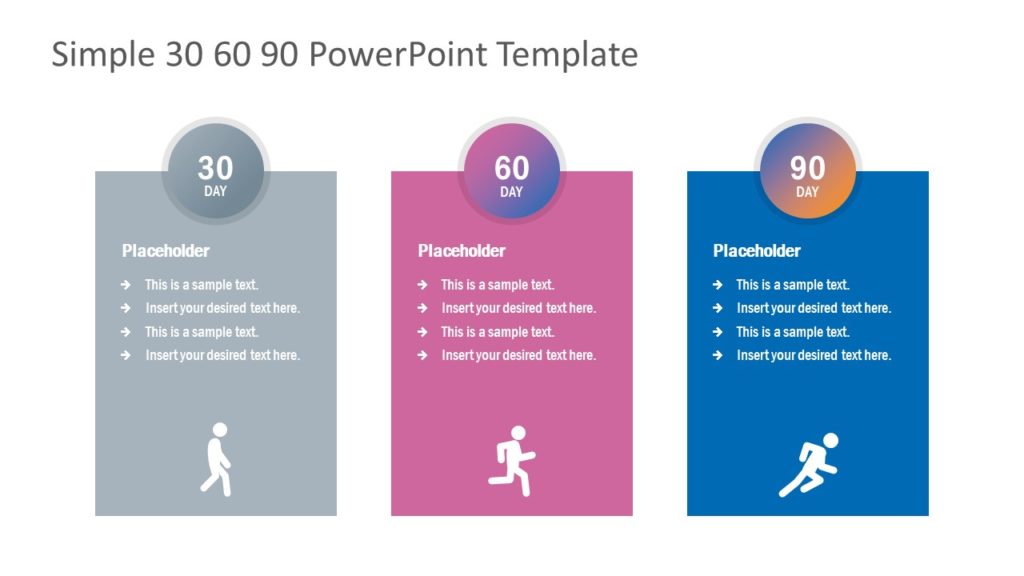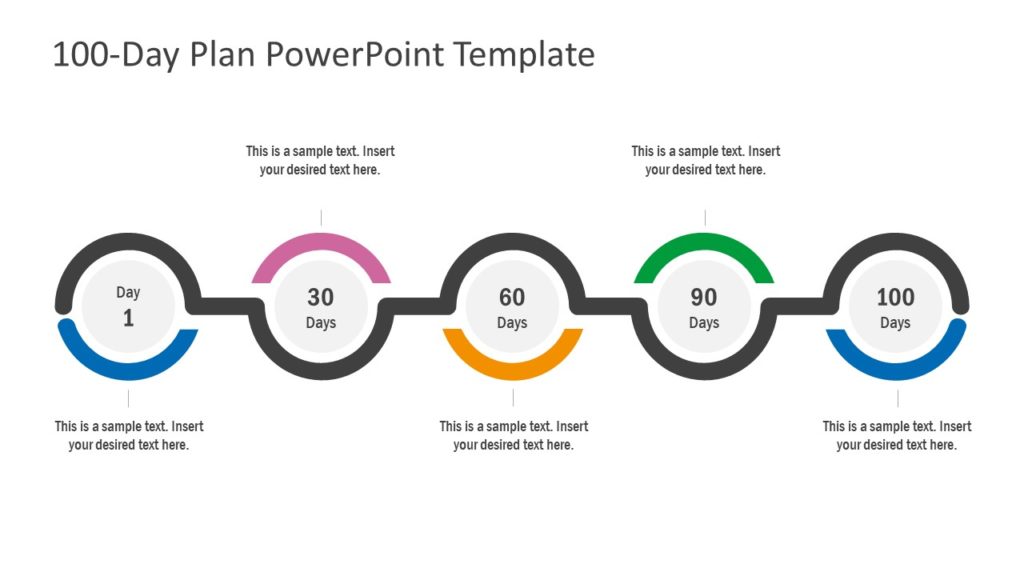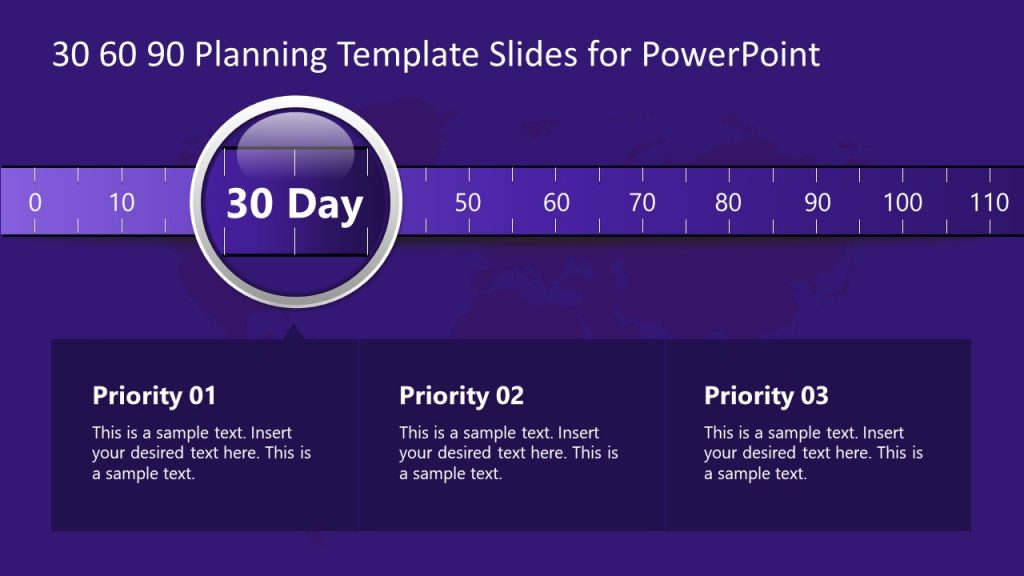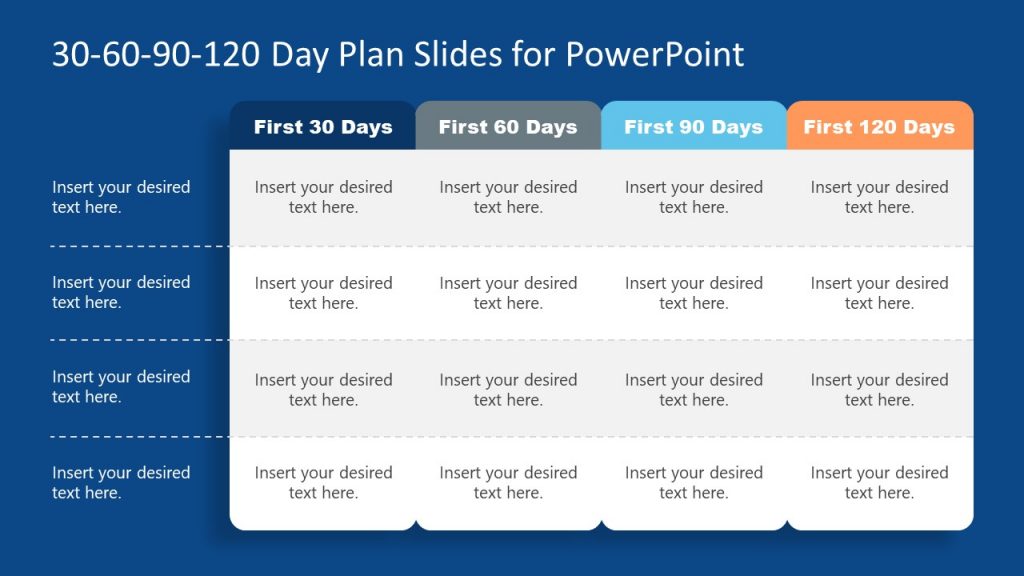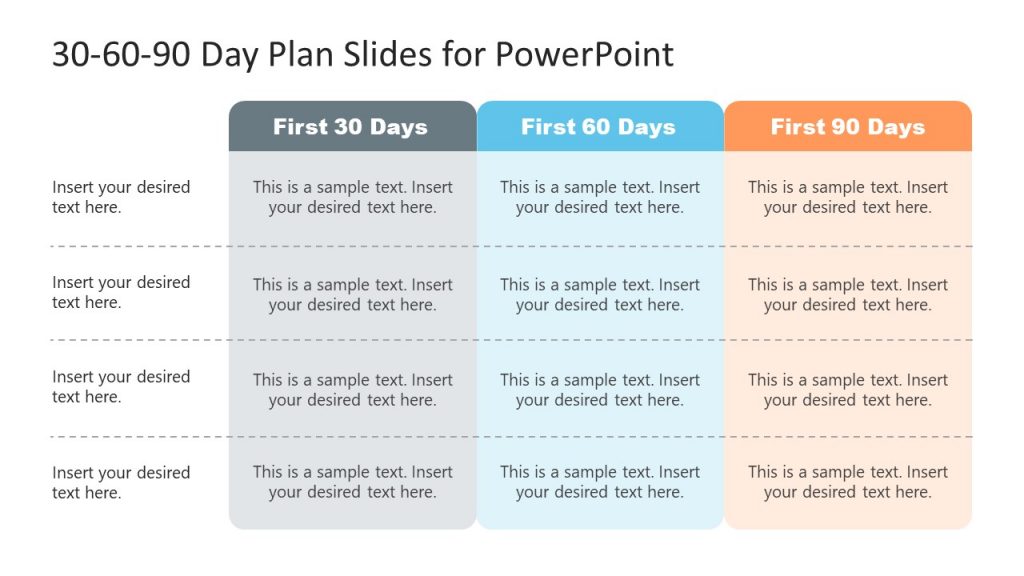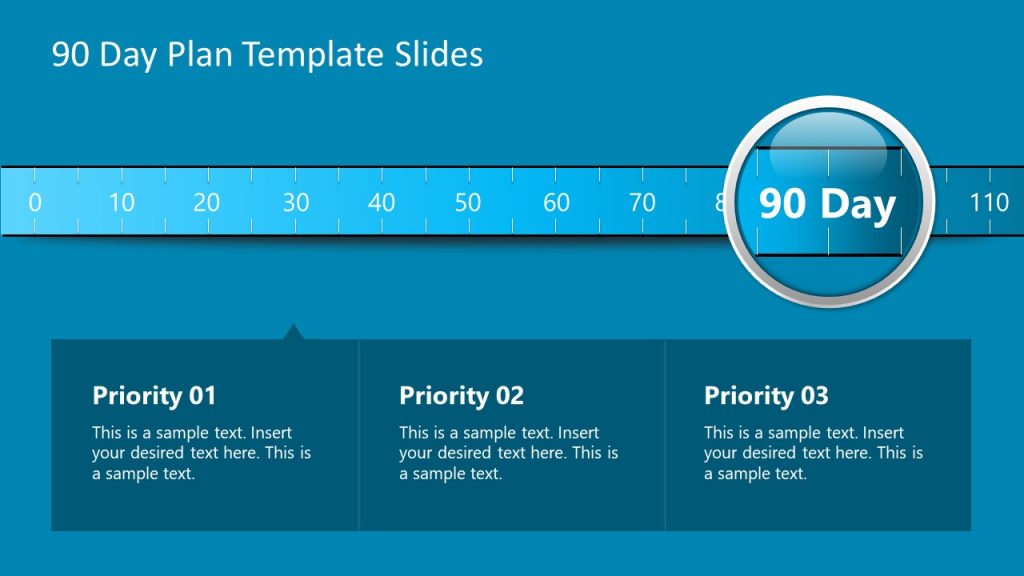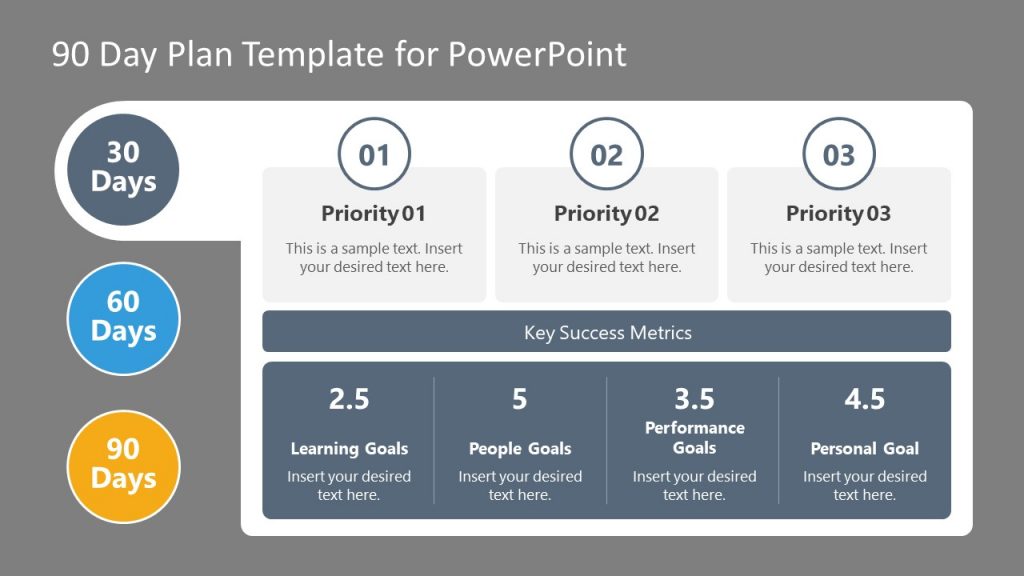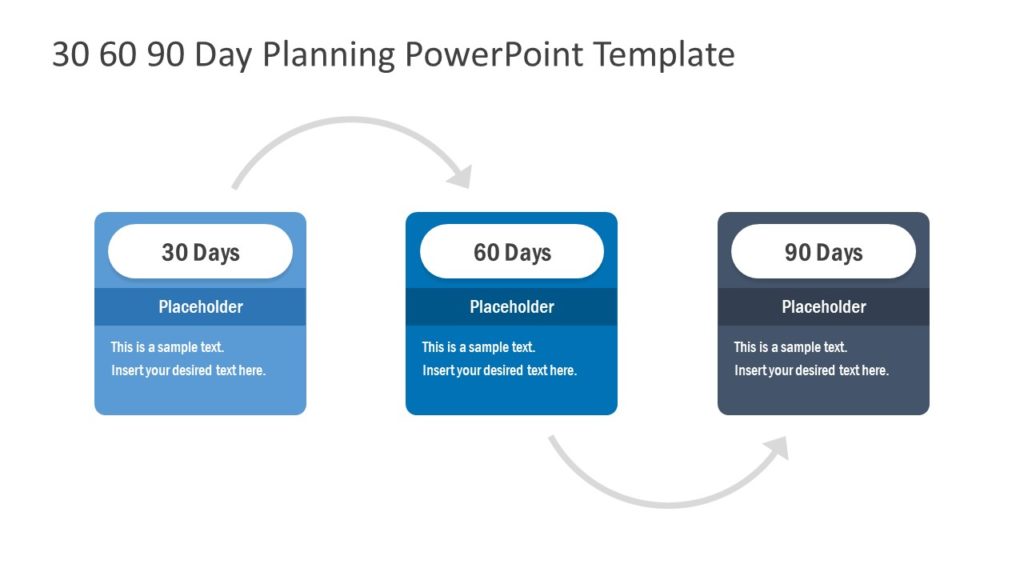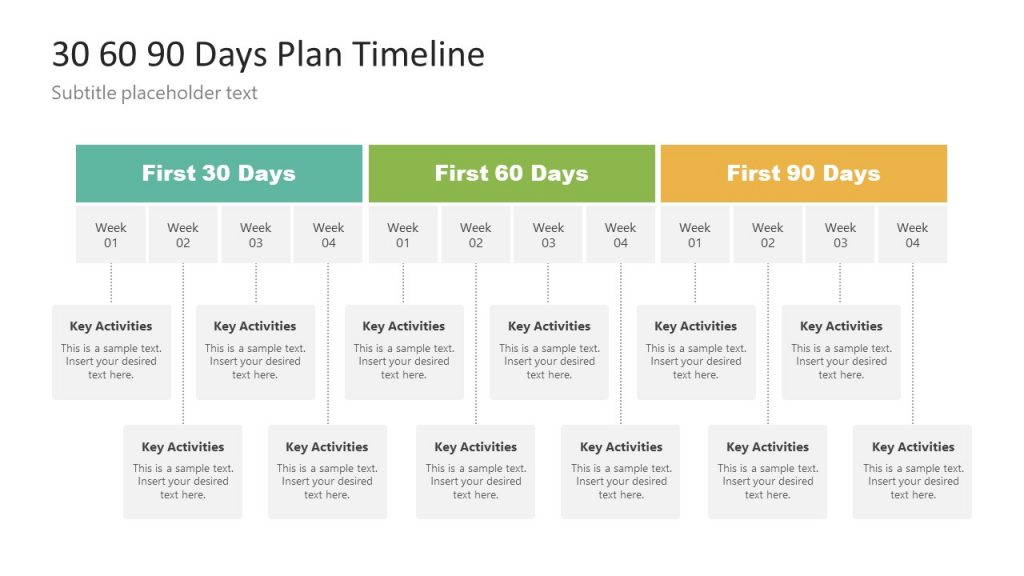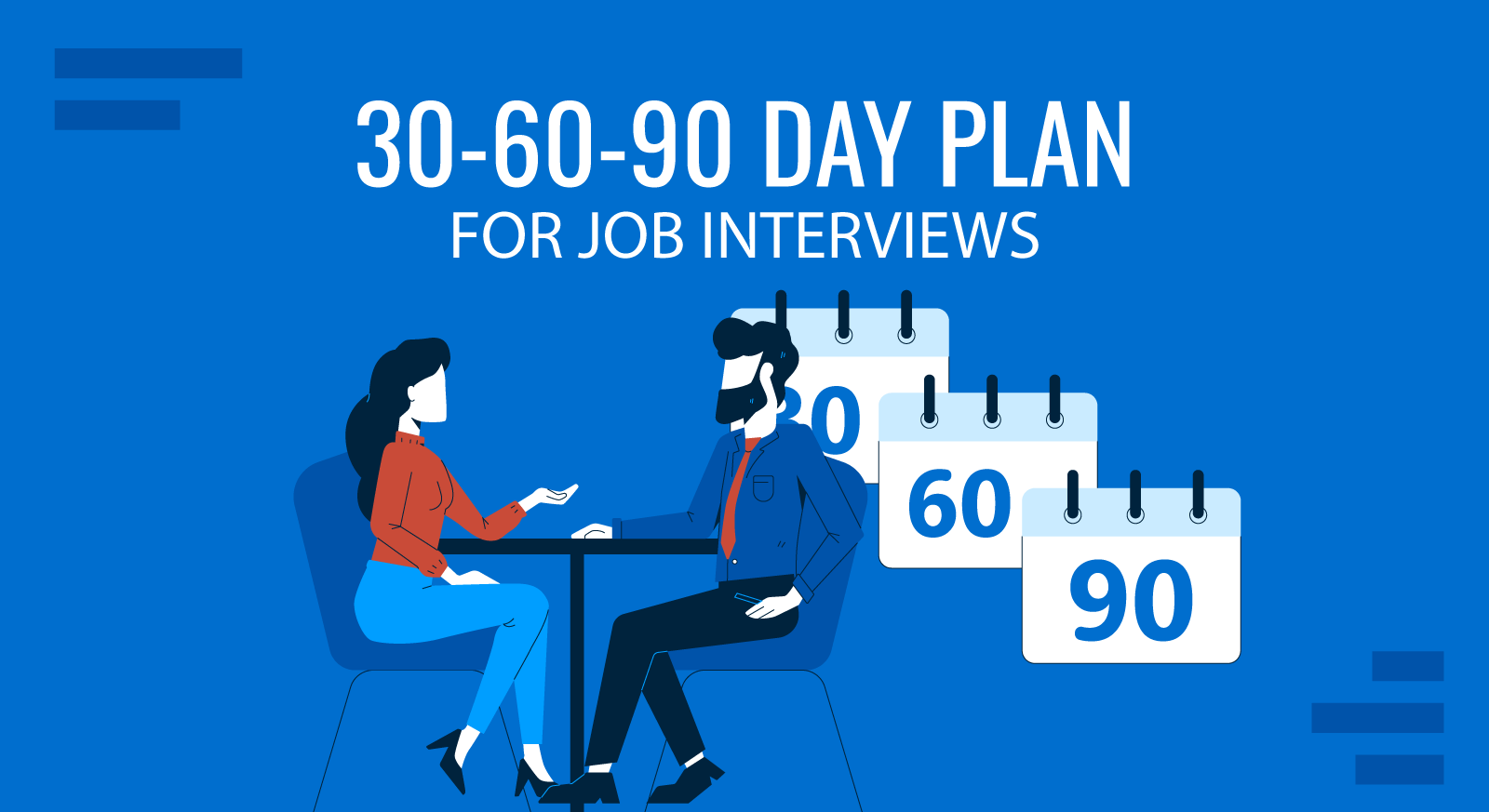
Some job interviews entail making or presenting a plan to show what can the new recruit offer the organization once he/she is hired. Depending upon the job title, there are various types of plans that one might require making such as perhaps a communications plan or project plan. However, the most common plan one might require making is a 30 60 90 day plan.
- What is a 30 60 90 Day Plan?
- Benefits of Creating a 30 60 90 Day Plan
- When to use a 30-60-90 day Plan?
- How to Create a 30 60 90 Day Plan for a Job Interview?
- Practical Example: How to Create a 30-60-90 Day Presentation for a Job Interview?
- Tips for Making Your 30 60 90 Day Plan
- Alternatives to 30-60-90 Day Plans
- Final Words
- 30 60 90 Day Plan Templates for PowerPoint
What is a 30 60 90 Day Plan?
Some employers ask candidates to present a 30-60-90 day plan. This helps employers understand the candidate’s skills, ability to create and manage measurable goals, foresight and willingness to be accountable for his/her work. The plan includes a roadmap to how the candidate aims to learn, add value and play a transformational role within the organization.
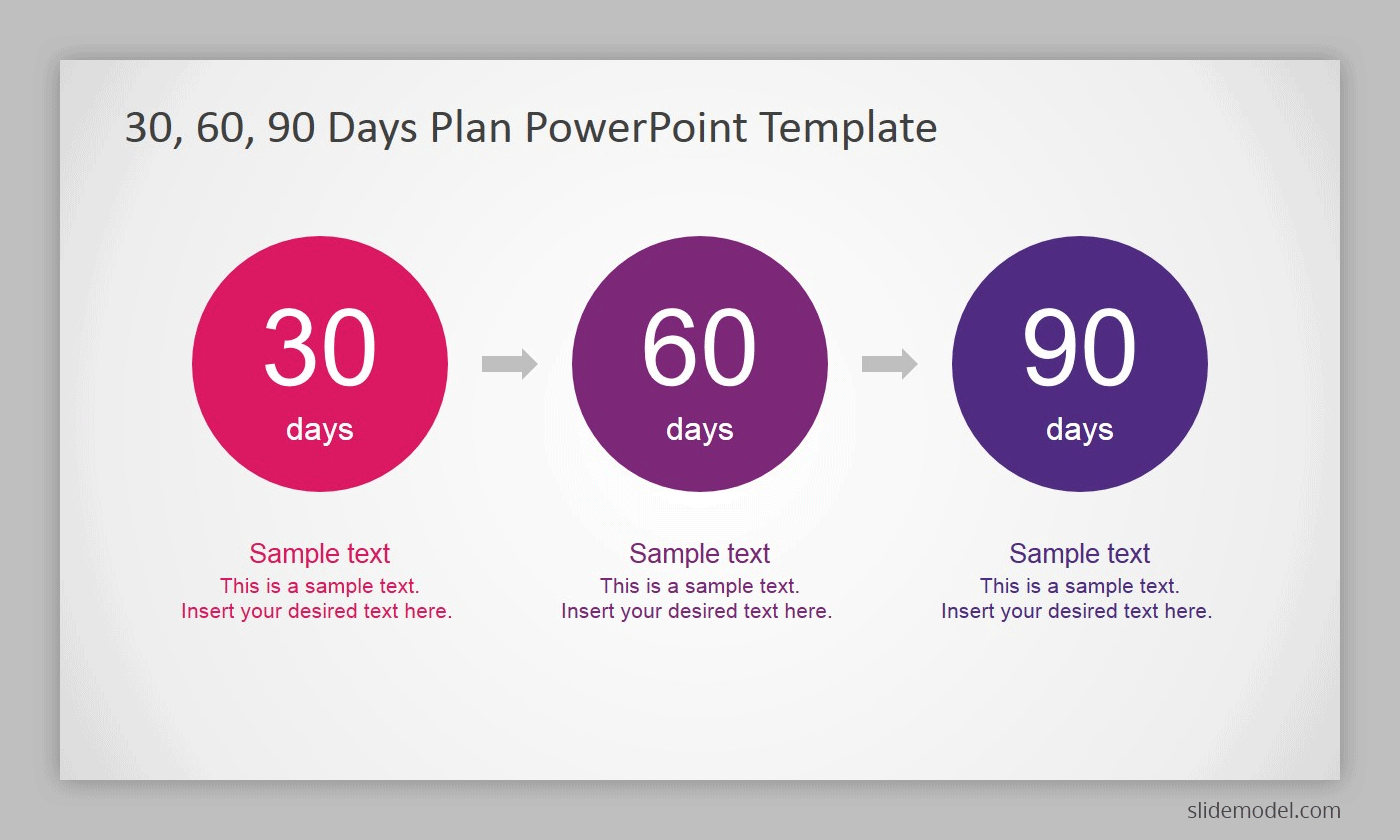
Organizations usually expect candidates to not only put in an effort to understand and evaluate the organization, projects and working environment; but to also add value, optimize procedures and bring positive change.
Benefits of Creating a 30 60 90 Day Plan
Whether your employer has asked for a 30 60 90 day plan or you take one along without any prior request from the potential employer, there can be a number of benefits for making such a plan. Similarly, the employer can better screen candidates if they ask for a 30 60 90 day plan.
Benefits for Job Applicants
Clarity in Job Expectations
One of the benefits of making a 30 60 90 day plan is that it provides clarity regarding what you might want from the new job. Furthermore, by dwelling into specifics of the advertised job description, you can also better understand the nature of the job and what you might have to offer to your potential employer.
If you’re someone rather new in your career or at an intermediate stage, making 30 60 90 day plans when trying to move up the career ladder can also be a way to sharpen your skills. You can see it as a tool that improves performance and productivity in the long run.
Better Preparation for a Job Interview
By making a 30 60 90 day plan, you can better prepare for a job interview. Many candidates can make the mistake of not paying attention to the job descriptions for dozens of jobs they might apply for. Once they receive an interview call, it can be tempting to skip the fine details. This is where you can fail during a job interview. Many times, it’s not the tough questions that can ruin your job prospects but a simple question that you failed to prepare for.
A Reflection of Professionalism
Some job applications create a 30 60 90 day plan even if the employer has not asked for it. This shows intent and determination, where a potential candidate has taken the time to better understand the job role and provide practical suggestions. Such an approach can make your potential employer see that you aren’t coming in with a casual approach. It also reflects on your professionalism in a positive way and can help you score some extra points.
Benefits for Employers
Helps Thoroughly Screen Candidates
Many candidates can be good at expressing their views but not all that good at implementing action plans. A 30 60 90 day plan template can help employers screen candidates more closely by analyzing the candidate’s capabilities and asking tough questions.
Enables Gauging the Experience of Candidates
When a potential candidate presents a 30 60 90 day plan, it’s not just a reflection of his/her ideas but also a reflection of the experience and expertise they bring along. Some candidates might be suitable based on their expertise and experience for the job compared to others. For example, when choosing between two candidates for social mobilization of rural communities, one might have experience working with large organizations, but the other candidate might be more suitable based on his/her expertise at the grassroots level. Such a distinction might mean the difference between someone who is more in touch with the environment he/she needs to work in compared to the other.
Can Help Attract Better Candidates
Arguably, asking for a 30 60 90 day plan can help weed out candidates with a casual approach who might not even want to put in the time to make such a plan. Such candidates might not even apply for the position, leaving room for better candidates.
When to use a 30-60-90 day Plan?
30/60/90 plans are often required at the time of job interviews and after an employee joins an organization. Such a plan is a reflection of how the employee intends to move forward during the first 90 days at the job, including how he/she shall learn, adapt, and perform at the workplace.
To put it in a nutshell, you should create a 30 60 90 day plan when applying for a job and it is quite likely you will need one when starting your new job. However, as mentioned earlier, even if the employer hasn’t asked for one, you can always create and bring along such a plan, be it a simple document or PowerPoint presentation. This is because such a move will give you clarity in your job role, will help you plan better for the job interview, and might even help you win a few extra points.
We also recommend you to read: The First 90 Days: Critical Success Strategies for New Leaders at All Levels by Michael D. Watkins to get some insight into how a 90 days plan can lead to success at the workplace. The book reflects upon leadership and career transitions. Joining a new job with a better salary and a few extra perks should not ideally be a goal. Negotiating with your new employer, moving up the career ladder, and ensuring success at the workplace requires leadership skills, your ability to bargain with your employer, team, and external stakeholders, is equally important.
How to Create a 30 60 90 Day Plan for a Job Interview?
If you have a job interview where you might require using a PowerPoint presentation to reveal your 30-60-90 day plan, you should focus on the key elements of the plan.
Key Elements of a Job Interview 30-60-90 Day Plan
The key elements of a 30-60-90 day plan for a job interview entail understanding processes, people, procedures, products and competition, evaluating processes and provide an action plan for optimization and transformation within the organization.
30 Days – Learning Phase
The first 30 days entail the learning phase, where you must understand the processes, procedures, your team, product and the competition.
Process, People and Procedure
The first 30 days are to get acquainted with your new job. The objective is to understand the team, processes and procedures. Understanding how things work within the organization would be key to moving things forward. Many project managers can become disconnected from company processes and their own team, leading to bad decisions and subordinate resentment. During your job interview don’t try to show that you know everything, since everyone needs to learn about the new company before they can take meaningful steps.
Product and Competition
During the first 30 days you will also be required to understand the product or service, its key features, the clientele and how competitors might be a threat to it.
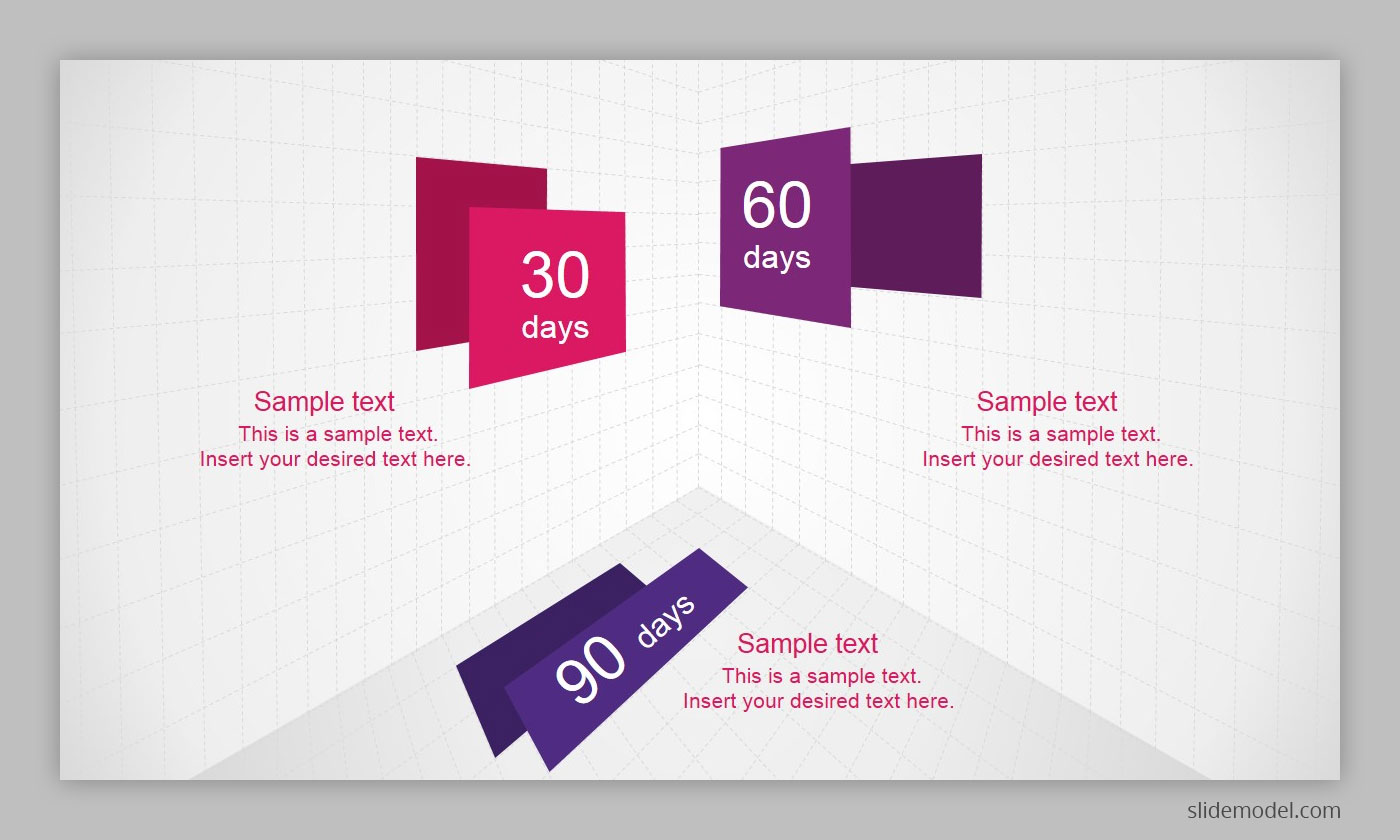
60 Days – Evaluation Phase
As evident from the aforementioned, the first 30 days, therefore, are all about learning the basics, followed by the next 30 days where you would move forward to the evaluation phase.
Evaluate Current Processes
The next 30 days (60 days) will include assessing current processes to understand how things work and to identify room for improvement. You might want to create a SWOT analysis to determine strengths, weaknesses, opportunities and threats. This will also help you allocate resources in the best possible manner to optimize your impact.
Evaluate Changes
Once you have evaluated processes, you now must try to evaluate grounds for bringing meaningful change. For example, you can identify cost-saving initiatives, methods for reducing waste, improving processes, lower per unit cost, etc. During this time, you would also be acquainted with the team (during the first 30 days) to determine what kind of change might be rational and what changes might lead to employee resentment and a possible backlash.
90 Days – Optimize
The next 30 days (90 days) would conclude 3 months, which is also usually the probation period for employees. This is the time when you need to deliver, or you might find yourself looking for a new job. If you set out with SMART goals, you should be fine during this time.
Initiate Action Plan
Based on your specific, measurable, attainable, realistic and time-bound (SMART) goals, you will require initiating your action plan. This will be a detailed plan with timelines and a scorecard to measure the success of your strategies.
Implement New Strategies and Procedures
During the last 30 days of the 30-60-90 day plan, you should start rolling out your new strategies and procedures. For example, a new process might be rolled out during this time or initiatives to cut costs and improve efficiency might be initiated.
Practical Example: How to Create a 30-60-90 Day Presentation for a Job Interview?
Now that we have discussed the basics of a 30-60-90 day plan, let’s take a look at how to create a 30-60-90 day plan example presentation to show your potential employer how you intend to add value and improve the processes, procedures, and project delivery.
Start with an Introduction
There is no point jumping right into the topic. You should start with a brief introduction of the topic at hand and explain what the plan is about. This is the section of the presentation that starts with a brief explanation of the topic.
The First 30 Days – Learning Goals
You should incorporate your goals within your presentation, starting with the learning phase or the first 30 days. You should briefly explain how you intend to learn about the processes, procedures, people and corporate culture, product or service and the competition to evaluate room for improvement. If you don’t have a lot of information regarding the organization, you can create sample goals based on hypothetical examples.
Many people can end up joining a job and thinking they have made a mistake. You need to have absolute clarity that the new job is something you are interested in, are looking to take the initiative to move forward with and can add value to the organization. Speak with clarity regarding your goals and if necessary, use hypothetical examples to give an example of what you might bring to the table.
You can also discuss strategies used by competitor organizations and even present a SWOT analysis in your presentation. Your information during this time might be limited regarding the organization, since you are unlikely to know specifics. But that’s alright, since employers expect the candidate to put in an effort in their plan and not know everything regarding the organization at the time of the job interview.
The First 60 Days – Initiative Goals
Based on the learning phase (first 30 days), you must set goals for taking initiative. As mentioned earlier, this is the evaluation phase where you would look for bringing changes to processes, procedures and perhaps team orientation to set out an outline for what might be rationally achievable. You can set SMART goals with indicators in the form of a scorecard for this purpose.
The First 90 Days – Transformation Goals
This part of your First 90 Days in a New Job presentation will focus on the change you intend to bring and the way you ensure it. You can explain how you intend to integrate your team with your organizational mission, vision, core values and bring improvement to existing processes, procedures and methods. You can also refer to a SWOT analysis to explain how your methods might be the right way forward for the organization. For example, in case the company is facing declining sales, you can incorporate a plan for improving market share, competing more effectively against competitors who pose a threat to the business and how you intend to capitalize on available opportunities (e.g. brand goodwill or making better use of existing marketing resources).
Timeline & Scorecard
Make sure that you incorporate a timeline and scorecard in your 30-60-90-day presentation. This will allow your potential employer to assess your capability of organizing your goals and get an overview of what your plan might look like at a glance. The scorecard will enable you to show how you intend to measure success and achieve your goals. This will help give a positive impression regarding your capabilities and clear out any possible confusion that your audience might have regarding your plan.
Tips for Making Your First 90 Days in a New Job Presentation
Make it Readable
Making a plan for your first 90 days in a new job presentation is too complicated might confuse your potential employer. One of the key aspects of making a robust 90 days plan is that it should be easy to understand. Try to keep the layout of the plan easy enough for your audience to understand and pay special emphasis on legibility. If it’s a document, use standard fonts. If you need to present your plan, do away with flashy templates and over-the-top animations and try to keep the layout easy to read and simple enough to present. And of course, avoid death by PowerPoint.
Set SMART Goals
It goes without saying that the goals you set out should be SMART, i.e. specific, measurable, achievable, realistic, and time-bound. You can analyze your goals once your plan is complete to ensure that they comply with SMART goals. Since this is a 90 days plan, you should try to focus on goals that are based primarily on the first 90 days, even if you plan to discuss a few long-term goals. You can also use a template that can help you easily layout your plan in the form of PowerPoint slides. For more information, we also recommend our section of SMART goals templates.
Identify the Company’s Mission
To create a 30/60/90 plan that is well received, you should ensure that your plan is in line with the company’s vision and mission. You can do a bit of research regarding that prior to your job interview. If you are making a plan after being hired, it is even more critical to ensure you don’t make a plan that can end up colliding with the corporate culture of the organization. To ensure this, you need to better understand the vision and mission statements of the company and any other frameworks they might have in place related to them.
Meet the Key Stakeholders
While it’s unlikely that you will be able to meet the key stakeholders at the time of the job interview, when making a 90 days plan after joining a job, you can meet the key stakeholders to help refine your plan. This would include both internal and external stakeholders such as peers, senior management, line managers, vendors, partner organizations, etc.
Be Flexible
While you might think you have a robust 30 60 90 day plan. It isn’t necessarily going to be perfect for your potential employer. You need to leave room for flexibility and adapt to potential challenges and suggested changes. Be it at a job interview or when making a plan after being hired, you need to ensure your plan isn’t rigid and can be adapted to unforeseen circumstances.
Determine How You Will Measure Success Example
To measure success, you will require adding a few KPIs (Key Performance Indicators). For example, if you are hired as a communications expert in the development sector, you will be required to elaborate upon how you can use digital technology to benefit the organization. Are you looking to overhaul the company’s social media presence? Are you looking to change the website design of the company website with a responsive UI? Do you plan to reach a specific number of targeted beneficiaries under a human development program using digital technology? Your KPIs should be in line with your SMART goals and should be realistically achievable during the laid-out timeline.
Alternatives to 30-60-90 Day Plans
There are a few alternatives to the 30-60-90 day plan. Let’s briefly take a look at a few 30-60-90 day alternatives.
Mintzberg’s 5Ps
Mintzberg 5Ps have been around since 1987. These 5Ps were the brainchild of Henry Mintzberg and include; Plan, Ploy, Pattern, Position and Perspective. These 5Ps serve as a roadmap for making a business strategy to make the most out of an organization’s strengths.
ADDIE Model
ADDIE stands for Analysis, Design, Development, Implementation, and Evaluation. Being an Instructional Systems Design framework, the ADDIE model is used by instructional designers and training developers for developing courses.

Source: ADDIE Model PowerPoint template by SlideModel
GROW Model
The GROW Model is used by executive coaches. The model is meant for setting goals and problem-solving. The model can be understood simply by its name, which stands for Goal, Reality, Obstacles, Options and Way Forward.
Final Words
Even if you are not asked to bring a 30-60-90 day plan, it might not be a bad idea to bring along one to improve your chances of scoring a job. A 30-60-90 day plan is essentially meant to assess the capabilities of a potential employee and what change he/she might bring to an organization. When making such a plan for a job interview, you should gather as much information regarding the organization as possible. You should also look into competitors, weaknesses in procedures, financial outlook of the organization, etc. This information is usually available on the organization’s website, via news articles and from companies dealing with trends related to the industry.
Your 30-60-90 day plan needs to be rational, with SMART goals and measurable success. You should not jump to conclusions but rather focus on rational approaches which might be implemented should you get the job. You should also account for aspects like a rigid corporate culture, possible non-cooperation of coworkers and procedures which might make it hard to implement your goals. In such a case you can mention pre-conditions for your 30-60-90 day plan to be successful. This is because many such plans can fail due to the bad working environment prevalent in particularly large organizations, where petty politics and slow procedures can be the bane of newly hired employees looking to implement strategies which might otherwise look rational.
30 60 90 Day Plan Templates for PowerPoint
If you are looking to create a professional plan for your new job interview, check out our 30 60 90 Day Plan Templates.
